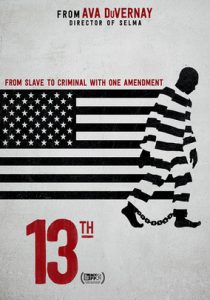13th-2016
Director Ava DuVernay
Scott’s Review #669
Reviewed August 5, 2017
Grade: B+
Hot on the heels of her successful feature film Selma (2014), director Ava DuVernay follows up with another race relations piece: an informative documentary entitled 13th, named after the Thirteenth Amendment to the Constitution of the United States of America, which abolished slavery.
The documentary, however, exposes loopholes in the Constitution and shows how progress has been too slow for black people since the Civil War and into modern times.
It looks at the escalating incarceration rates of the United States black population over the years and how the prison system as a whole has been used as both a money-making system and as a way of controlling minorities.
The documentary examines the United States prison system. It starts with an audio clip of former President Obama informing us that the United States has five percent of the world’s population. Twenty-five percent of the world’s prisoners are in the US, a direct message to those convinced that the US is the greatest country in the world.
This powerful message sets 13th off right as we explore why the statistic exists.
I thoroughly enjoyed the high production values of the documentary, including the modern graphics that edgily displayed the number of incarcerated blacks on screen.
13th does not feel dated or monotone as some documentaries do. Instead, it feels creative and nuanced with interviews and news clips of events such as the Civil Rights movement and Depression-era footage. Modern-day footage is included, representing over a hundred years of history.
A significant aspect of the 13th is its chronological progression through history, beginning with the Civil War and ending in 2017 when the unpopular Donald Trump was elected President of the United States.
The gloomy implication is that, with the current (2017) presidency, the minority population is still repressed and discriminated against by many political figures and that they are still primarily feared and blamed for the “perceived” high crime rates.
DuVernay’s central point is that many political figures use “scare tactics” to influence voters to vote a certain way and repeatedly fall for this strategy.
She analyzes the history and dissects several presidents’ terms and individual campaign messages, heavily featuring Nixon, Reagan, Clinton, Bush Sr., and Obama.
I love this aspect since it was a fresh history lesson for me on how the times have changed but have stayed the same.
13th avoids being too preachy and presents “both sides of the aisle.” Some feel that political figure’s harsh take on crime is not meant to repress minorities. A few of these folks are interviewed and given time to explain their viewpoints, but the film is mainly left-leaning in tone and views.
The negative portrayals of Trump, Nixon, and Reagan are proof of this.
Interviews with prominent activists such as Angela Davis, leader of the Communist Party USA, and a woman with close ties to the Black Panthers are informative. Considered a radical in her day (the 1960s), the documentary features clips of her interviews both then and now.
Current political figures Van Jones and Newt Gingrich are featured, giving 13th a crisp, modern, and relevant feel rather than a long-gone period.
Overall, I found 13th (2016) to be an educational and historical lesson in the challenges and race issues that people of color have dealt with over the years and how their world is still affected by current legislation and decisions by political figures (mainly white), who hold all the cards and repress people who speak out against them.
Oscar Nominations: Best Documentary-Feature
Independent Spirit Award Nominations: Best Documentary Feature
